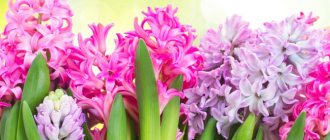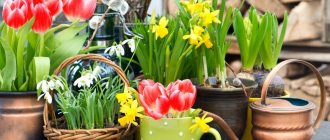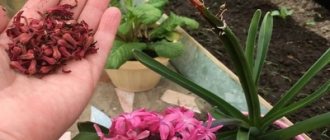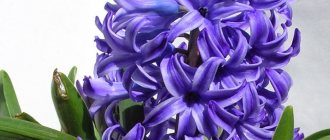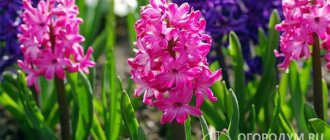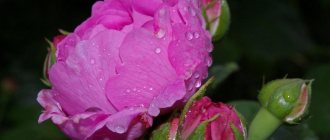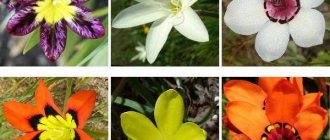How to choose hyacinth in a pot in a store
In early spring, stores begin to sell blooming hyacinths of various colors. If you decide to purchase a plant more than once, you need to choose the right hyacinth in a pot so that further forcing will be successful.
- Pay attention to the stem and peduncle, they should be erect.
- The plant bulb should be quite large - more than 5 cm in diameter.
- Look for any cracks, dents or pest damage on the bulb.
Feel free to take it if the plant looks healthy, with a dense bulb and bright leaves.
Is the strong aroma of hyacinths a problem?
Hyacinths have a very contradictory aroma, the perception of which depends not only on the subjective preference of a particular person, but can also vary greatly depending on the variety. Therefore, the smell of hyacinth can be described as both “very unpleasant” and “incomparable floral.”
In this regard, if you have never expelled hyacinths before, it is worth keeping in mind that you may not really like their smell. Personally, I associate this aroma with the approach of the long-awaited calendar spring, although I also sense some unpleasant notes in the aroma of certain varieties.
According to my observations, blue hyacinths smell most gently and pleasantly, but at the same time quite intensely. But the most unpleasant notes, ironically, are found in rare colors, in particular salmon and yellow. Blue hyacinths most often smell moderate, slightly bitter and quite pleasant. Among them you can also find varieties that are completely devoid of aroma.
It is worth driving out hyacinths with caution if there are people with allergies or people suffering from bronchial asthma in the house. There is also an opinion that in people prone to migraines and hypertension, the aroma of hyacinths can provoke headaches and increased blood pressure.
But at the same time, the smell of hyacinth has a positive effect on many people: it calms, relaxes and lifts their spirits. In any case, I would not recommend placing blooming hyacinths in the bedroom. In her apartment she gave them a permanent place in the kitchen.
What to do with hyacinth after purchase
Flower growers disagree on whether it is worth replanting a blooming hyacinth just bought at the store.
Plants are sold in cramped pots, in which there is too little space for the bulb, not enough nutrient substrate, and the soil dries out too quickly. Therefore, if you see the need to replant a plant, you can carefully do it. To do this, thoroughly moisten the soil in which the plant is located and carefully transfer the bulb into a larger pot. Cover with soil, but do not bury the neck of the bulb.
After transplanting into a larger container, the plant not only looks better, but also becomes easier to care for. After flowering, it can be grown in the same pot.
Mold on the surface of the soil - is it necessary to fight it?
During the cold rooting period, when containers with hyacinths are in the refrigerator or in the basement, mold often forms on the surface of the soil, as well as on the bulbs themselves. For novice gardeners, this can provoke panic and suspicion that mold indicates a disease of the bulbs, which will ultimately lead to their rotting.
In fact, mold is a common occurrence when forcing hyacinths and other crops. Its appearance is due to favorable conditions for its growth - lack of light and high humidity. But as soon as the container with hyacinths gets into normal room conditions, and later on a sunny windowsill, this problem will be resolved on its own. Very soon there will be no trace of mold left, and its existence in the past will not cause any harm to the bulbs.
If you are still very concerned about the presence of mold or there is too much of it, then it is enough to spill or spray the soil with any fungicide. In particular, bacterial preparations (Fitosporin, Trichodermin, Alirin, etc.) are very helpful in this case. To prevent the appearance of mold, you can add crushed Glyokladina tablets to the top layer of soil.
Flower care requirements
To obtain bright hyacinth flowers, it is necessary to take into account various features in its care.
Temperature and lighting
Hyacinth prefers bright, diffused light for at least 12 hours a day. Windows facing south and southeast are perfect for it. If the lighting is insufficient, the plant can be artificially illuminated. And so that the plant develops evenly and does not stretch one side towards the light, the pot with the bulb must be rotated regularly.
Comfortable temperature for hyacinth is 20–22 degrees. It should also be taken into account that sudden temperature changes, drafts and hot heating devices have a negative impact on the plant and can destroy it.
Watering and humidity at home
Hyacinth is a moisture-loving plant. Therefore, it is important to always keep the soil in the pot slightly moist. But the water should not stagnate, otherwise the plant may rot.
Watering is carried out with soft water, standing for 24 hours, at room temperature. When watering, it is important not to wet the bulb, leaf axils and buds. It is worth watering along the edge of the container, and if the pot is small, then you can water it in the pan.
Do not spray the plant, especially during flowering.
Soil and fertilizing
In specialized stores you can purchase a mixture for bulbous plants. To prepare the soil yourself, you need to mix in equal proportions:
- turf land;
- leaf soil;
- compost;
- sand;
- peat.
Perlite or vermiculite can be added to the hyacinth substrate; they retain moisture and promote soil aeration.
Preliminary tillage of the soil will avoid damage to the bulb by pests and reduce the risk of fungal diseases.
The soil in the pot is quickly depleted, so hyacinth needs regular feeding. During the growth period and at the budding stage, the plant is fed 2 times a month with fertilizer to stimulate flowering. Plants are fed from the very beginning of growth until the end of flowering. After the plant has flowered, it is fed with complex fertilizer.
Choosing a pot
A pot made of any material is suitable for hyacinth: plastic, clay, ceramic. The main thing is that it is deep, with a diameter 3–4 cm wider than the bulb. It is imperative to have drainage holes.
You can plant several types of hyacinths in one container, then during flowering you will have a beautiful and lush bouquet.
Reproduction methods
There are several methods, but in most cases amateur gardeners use one: cutting or cutting the bottom. Breeders use seeds to breed hyacinths and develop new varieties.
Children
The method is used less frequently than bottom treatment. The reason is the small number of new bulbs that can be obtained in one go.
Seeds
A fairly complex method is rarely used at home. Growing hyacinth from seeds is most often done by breeders. The method is expensive, there is no need to waste time on a complex procedure: it is easier to process the bottom of the hyacinth, and in one go, in a couple of months you will get many children.
Cutting and notching the bottom
An effective and relatively simple procedure for home use. The advantage is the opportunity to get a dozen or more young bulbs. They say that this method was accidentally “invented” by Dutch flower growers, or rather, by a mouse. The gray “mistress of the basement” nibbled the bottom, and after a while the grower found several new bulbs in the damaged bulb. Since then, processing the bottom has produced many hyacinth babies without unnecessary hassle or problems.
How to proceed (cutting the bottom):
select a large onion (6 cm or more), remove the soil, rinse, dry for two to three days in a ventilated room with moderate temperature; the bottom (lower part) is cut crosswise, preferably at an angle of 90 degrees to a depth of 0.5 cm; lay the base for hyacinths with the cuts facing up, wait until parts of the bulb open slightly; to disinfect and reduce the risk of rotting, the pulp is sprinkled with activated carbon powder; then place the planting material in a dark room with a temperature of +20°C; It remains to wait three months: during this period, young bulbs are formed, which are carefully separated from the mother base, placed in wooden boxes and grown.
Another way is to cut out the bottom. Despite the rather threatening name of the method, future plants do not suffer from problems.
What to do:
- the bottom is cut from large onions using a sharp teaspoon;
- planting material is laid out in wicker baskets with the cut side up, the container is transferred to a pantry with a moderate temperature: from +21 to +22°C and no lighting;
- young onion “babies” are formed over the course of two to three months.
The appearance of a peduncle and further care of the flowering plant
With proper care, the hyacinth quickly develops a peduncle. As soon as leaves begin to emerge from the bulb, developing buds can be seen.
Now, for good flower development, it is necessary to maintain a temperature of about 20 °C, protect from temperature changes and drafts. Twice a month, fertilize the plant with fertilizers to stimulate flowering and maintain the soil moisture necessary for the plant.
Description of the plant
Hyacinth belongs to the perennial bulbous herbs of the Asparagus family. The plant consists of a dense flat-round bulb, the scales of which in the upper part turn into narrow leaves. From its center grows a flower stem with an inflorescence in the form of a brush with small fragrant flowers of various shades from snow-white to blue-black. After flowering, capsule-shaped fruits containing seeds are formed.
In nature, hyacinth reproduces both generatively - by seeds, and vegetatively, with the help of children that appear around the circumference of the bottom of the bulb. Under natural conditions, hyacinths grow in the countries of Southern Europe and Asia Minor. Several centuries ago, its fragrant inflorescences of bright and delicate colors were noticed by European breeders.
Important! The varieties with white and light flowers smell the most intensely.
To date, more than five hundred varieties of hyacinths have been bred. The homeland of most of them is Holland, whose mild climate and light, moist soils are ideally suited for growing this fastidious “rain flower.” For successful cultivation, you just need to recreate its usual conditions and take into account the natural cycle, when the dormant period precedes the flowering time.
Replanting after flowering
If the hyacinth was not transplanted into a new, larger pot immediately after purchase, then this must be done after the plant has flowered.
For transplantation you need:
- prepare the container;
- buy or prepare soil yourself;
- pour expanded clay onto the bottom of the pot and cover it with a layer of soil;
- Place the bulbs at 2/3 of the height, so that they do not touch the walls of the pot.
Important. The neck of the bulb must be above ground level, otherwise the plant may rot and die.
How to save a bulb after flowering
Further care for the bulb is simple; you just need to know a few rules:
- After the plant has flowered, you need to cut off the peduncle, leaving the leaves.
- If the plant is in a small pot, then it should be transferred to a larger container without deepening the neck of the bulb. This way the plant will continue its development and growth of children.
- It is best to keep the plant in a cool, bright place.
- Now you should water the hyacinth less abundantly and after the soil dries out.
- Around mid-May, the leaves will completely dry out and watering should be stopped.
- Next, you need to cut off the dried leaves, pull out the bulb and carefully clean it from the soil, remove dead scales.
- Dry the bulbs for 3 days.
- Store the bulbs in a dark, warm, well-ventilated area, in a cardboard box, paper bag or sawdust for about 2 months.
- A month before planting, the bulbs must be kept in a cool, damp room with a temperature no higher than +5 °C.
The hyacinth flowering phase lasts 2-3 weeks. The flowering period must necessarily be replaced by a dormant period; it is important to ensure a smooth transition between them. This will allow the bulb to rest and gain strength to continue to delight you with bright flowers.
Three stages of hyacinth development
The development cycle of hyacinth throughout the year can be divided into three periods:
- Spring growing season (lasts 3 months) - appearance of leaves, flowering, formation of daughter bulbs.
- Summer dormancy (3 months) - begins after the leaves dry out; at this stage the bulb should be at a temperature of about 25 ° C.
- Winter dormancy (6 months) - lasts from mid-fall until spring leaf growth.
All three periods are necessary for the development of a bulbous plant. Moreover, they can be created artificially by trying to get hyacinth to bloom at unusual times. The technology of forcing flowering is called forcing. It is these forced hyacinths that we buy in pots in winter and early spring.
To grow blooming hyacinth, you need to maintain the correct temperature throughout the year.
Answers to frequently asked questions
What to do with the flower after flowering?
Lush flowering of hyacinth takes a lot of energy from the bulb. In order for the plant to please you again with beautiful flowers and a wonderful aroma in a year, you need to give it a rest.
After flowering you need:
- cut off the peduncle;
- reduce watering;
- feed with complex fertilizer;
- wait for the leaves to dry, remove the bulb from the pot, clean it from the soil;
- dry the onion;
- put in a cool place.
In the fall, when the hyacinth bulb has rested, it is planted in open ground. The plant may not bloom in the spring, but this will prepare it for forcing next season.
Bulb requirements for healthy growth
A high-quality bulb is the key to beautiful flowering. When purchasing a potted hyacinth, carefully inspect the plant. The stem and peduncle should stand straight, without tilting, the leaves also look up.
For forcing in a pot, the bulb must meet certain requirements:
- choose a large onion with a diameter of more than 5 cm;
- the bulb should be elastic with clear scales;
- Make sure there is no damage or mold.
Experienced flower growers recommend purchasing hyacinth bulbs in trusted places and specialized stores.
Is it possible to adjust flowering to a certain moment?
Many gardeners also love hyacinth because it can be made to bloom at a certain time.
To determine the start date of forcing, it is necessary to count 3-3.5 months from the date on which flowering should occur.
During this time you need:
- place the bulb from a warm, dry place for 2–3 weeks in a dry but cool place, 5–10 °C;
- then the bulbs are planted in a pot, watered and left for 40–45 days in a cool, dark place;
- then placed for 10 days in a warmer - 15 ° C, but dark place.
At the end of forcing, the bulbs are transferred to normal conditions (on the windowsill). Over the course of a month, they will form a flower arrow with a bud.
If you need to get hyacinth to bloom by March 8, forcing should begin no later than mid-November.
When can you separate children?
After the faded bulbs have been removed from the pot, cleaned of dry leaves and soil, the children can be separated from them. If the children are firmly attached to the mother plant, they will easily detach before autumn planting, when the bulbs dry out.
Why does Hyacinth have a short peduncle and leaves fall out of the bulb?
There may be several reasons for this:
- non-compliance with temperature conditions during rest;
- insufficient watering;
- lack of fertilizing or irregularity of its implementation;
- aging of the bulb.
Is it possible to keep hyacinths in the bedroom?
If there is enough light in the room for this plant, and its rich aroma does not cause unpleasant sensations to the people who relax there, then there are no contraindications to placing hyacinth in the bedroom.
Some even believe that hyacinth charges people with good energy and has a beneficial effect on family relationships.
What care is needed while at rest?
After the hyacinth leaves have completely dried, the bulbs need to be removed from the pot, then dried well at home. They are disinfected with a solution of potassium permanganate, and all dead scales must be removed. When babies form on the bulb, they need to be planted in the ground. Children will be able to produce a flower stalk only after a few years.
Before autumn, at home, hyacinth bulbs should be kept in boxes or pots with peat or sawdust. Storage is carried out according to the following method:
- for one and a half months the temperature is maintained at 20 to 22 degrees;
- within 2 weeks – from 16 to 18 degrees;
- short-term exposure to low positive temperatures, for example, place in the refrigerator for several days.
After this preparation, the hyacinth bulbs are ready for planting. They are planted in open ground at the onset of the first autumn frosts. It is unlikely that the plant will bloom next spring. After being forced out under industrial conditions, hyacinth will need 1-2 years to restore its resources. If you properly care for hyacinth, it will delight you with lush inflorescences for 10 years.
If it is impossible to plant hyacinth in an open area, you can use another care option. After trimming the dried leaves, the pot with the hyacinth bulb is placed in a cool place, away from light. Watering is not carried out during this period. After 3-4 months, new leaves will appear on the bulb. Then the container with hyacinth should be placed in a lighted place, protected from drafts and watered moderately.
Using the correct method of caring for hyacinth at home allows the bulbs to replenish their biological reserves of resources and delight their owners with lush flowering the following year.
How to plant hyacinth at home
Preparing the bulb
After the required dormant period, we select healthy, dense and large bulbs, more than 5 cm in diameter. To protect the plant from diseases, the bulbs are treated with one of the antifungal solutions.
Boarding time
Most often, they want to receive blooming hyacinth for a certain holiday, for example, March 8 or Valentine's Day. On average, after planting, the plant blooms within 3-3.5 months. Therefore, in order to receive flowers on time, you need to calculate the planting time in advance.
Soil preparation
Before planting plants, it is necessary to disinfect the soil. To do this, you can bake it in the oven for 30 minutes or pour it with a fungicide solution.
Landing
Hyacinth bulbs can be planted in an individual pot or in a flowerpot several at a time, at a distance of 2-3 cm from each other, to obtain a lush bouquet.
- It is necessary to add drainage to the bottom of the pot.
- Fill the pot 2/3 with soil.
- Plant the bulbs at half their height.
Rooting period
After planting, the plant must be watered without touching the bulbs and the pot must be placed in a cool, dark place at a temperature of about 5 degrees for the plant to root.
The final stage of forcing
After the sprout appears, about 5 cm high, the plant can be placed in a bright and warmer room.
When buds begin to form, the plant is transferred to a bright, warm room with a temperature of 20–22 °C.
Important. It is necessary to ensure a smooth change in temperature.
Forcing in water
Some gardeners prefer to force hyacinth without soil.
To do this, select a glass container with a neck of smaller diameter than the onion. Water is poured into the container so that the distance between the water and the onion is about 5 cm. The container with the onion is placed in a cool, dark place. And with the appearance of roots, they are transferred to a bright room.
Fertilizer must be added to the water once a month.
Characteristics of hyacinth
Hyacinth is a herbaceous bulbous perennial from the Asparagus family. Grows from 20 to 40 cm. The leaves are succulent, linear - from 4 to 8 pieces in a basal rosette. The buds are clustered in a cluster (sultan) on a fleshy, thick peduncle. The flowers look like bells. As they open, the petals arch. The bulb can be rounded or cone-shaped - the average diameter is about 6 cm. The color of future flowers is determined by the color of the outer scales:
- purple bulb - azure, purple or blue flowers;
- lilac - pink, crimson, light gray;
- brown - yellow, beige, peach, scarlet, orange.
Regardless of where hyacinth grows - at home in a pot or in a garden - it blooms once per season, for 10-14 days. With good care and optimal conditions - up to 25 days.
Propagation of hyacinths at home
Reproduction by children
During the time that the plant is in the soil after flowering, 2–3 children are formed on it. After the mother bulb is dried, the children are separated from it and sent on vacation with it.
In the fall, the children are planted in the ground. They will begin to bloom only after 3–4 years, when they reach the size of an adult plant.
Cuttings
During the period when the hyacinth began to form buds, you can prepare cuttings for its propagation. To do this, you need to select a leaf and cut it off at the very base of the bulb. The cut is treated with a disinfectant and growth-stimulating drug. Planted obliquely to a depth of about 3 cm in a container with substrate. Cover with film and keep in diffused light and room temperature. After about a month, 2–4 sprouts appear. When they grow a little, small bulbs are planted in a pot or greenhouse.
Cutting the bottom
This is one of the methods of artificial propagation of hyacinths, which produces a large number of children, more than 20 pieces.
To reproduce in this way you need:
- after the dormant period, choose the largest and healthiest bulbs;
- Use a sharp blade to cut the bottom and place the onion cut side up;
- at a temperature of 20–22 °C, after 2–3 months, babies form on the bulb;
- now the mother onion can be planted in a greenhouse;
- When the first shoots appear, you need to separate the children and plant them in separate pots or a common box.
Bulb dissection
A large, dense onion should be divided into 5–6 parts with a sharp knife. Separate each slice into scales. Treat sections with a disinfectant.
The scales are stored in plastic bags. In the first month at a temperature of +20–25 °C, in the second – +17–20 °C.
During this time, 1–2 bulbs form at the base of the scales.
This method can produce up to 50 seedlings from one mother bulb.
Digging and storing hyacinth bulbs
Next, the bulbs are dug out of the ground and sent for summer storage - for 2.5-3 months.
Work order step by step:
- The bulbs are carefully removed and cleaned from the soil. The roots and loose scales are removed. If you eat small onions (babies) on the mother bulb, they are separated and also sent for storage. Afterwards, they are grown for 2-3 years in exhaust gas to an adult size; they are too small for flowering.
- The dug up bulbs are washed and disinfected in a warm, deep pink solution of potassium permanganate or in Maxim for 30-40 minutes.
- After cleaning, the bulbs are dried for 5-7 days in a dark place with good ventilation, at a temperature of 18-20°C. Humidity is average – 45-60%.
- Next, the bulbs are placed in paper bags and sent for storage in a dark place at a temperature of 25-30°C. Exposure time - 1 month.
- Then the storage temperature is reduced to 17-20°C. They are kept in such conditions until planting in the ground - in mediocre conditions, until mid-October.
Hyacinth bulbs are stored in paper bags, wrapped in newspaper, in cardboard boxes or boxes.
Please note!
Planting material is not stored in the refrigerator or in plastic bags.
Diseases and pests
Like any plants, hyacinths are subject to various diseases or pest attacks.
Yellow bacterial rot
During this disease, the bulb liquefies. An unpleasant odor begins to emanate from it, and the plant stops growing. The onset of the disease can be recognized by the gray spots that appear on the leaves.
Parasitic blossom end rot
The disease is caused by pathogenic microorganisms found in contaminated soil. Small brown depressions appear on the flowers and leaves of the plant, the tips of the leaves become thinner and destroyed, and the roots rot.
Mosaic
Chaotically located elongated light green spots appear on the leaves and flowers. The affected areas begin to turn yellow and dry out. The plant slows down its growth and may die.
Gray rot
Most often it affects plants during the period of early growth. Yellow spots form on the plant, which gradually increase in size and become brown in color. The disease quickly affects the roots and the plant dies.
Pests
The main pests of hyacinths are aphids, spider mites, nematodes, flower flies and mole crickets. Plants become depleted, leaves turn yellow and wither, buds fall off. If pests are not noticed in time, they can destroy the plant.
Insecticides, which are sold at any garden store, help in controlling pests.
Common Growing Problems
When growing hyacinth, the following problems may arise:
- Too slow growth of the peduncle, opening of flowers in a leaf rosette;
- Yellowing of leaves;
- The buds fall off before they have time to open;
- Flowers are not formed;
- Flowers turn out deformed;
- The leaves are elongated, drooping;
- Bulb rotting;
- Bulbs planted together bloom at different times;
- Leaves and stems fall out of the bulb.
Diseases and pests
Common ailments and parasites that pose a danger to hyacinth include the following:
- Fusarium (fungal disease). It manifests itself in the fact that the stems and leaves begin to fade. A characteristic sign is the presence of mucus on the surface of the bulb. An advanced disease cannot be cured. In case of minor damage, all affected parts of the plant are removed, the cut points and the bulb are treated with sulfur or activated carbon. The plant should be kept separate from other house flowers.
- Bacterial rot. Symptoms are the appearance of black spots on the leaves and a mucous coating on the bulb. The disease cannot be cured. The affected hyacinth is destroyed, the pot is treated with a disinfectant, and the soil is thrown away. Before replanting, it is recommended to treat the bulbs with a phosphorus-containing substance.
- Aphid. Characterized by yellowing of leaves. Colonies of parasites can be seen on the tissues of the flower. To rid the plant of pests, you need to treat it with insecticides, for example, Actellik.
- Stem nematodes.
Signs:
- Changing the shape of leaves and peduncles;
- The appearance of thickenings;
- The affected areas turn pale, then turn brown;
- Diseased areas die.
The diseased hyacinth is destroyed (burned). The bulbs can be left, but before replanting the hyacinth, they must be immersed in hot (45 degrees) water for 15 minutes, then rinsed and dried.
Root mite. The parasite eats the bulb, causing it to fall apart, leaving only rot inside. Treatment consists of treatment with an insecticide (for example, Apollo). Prevention - do not allow the bulb to become waterlogged.
Care errors and their elimination
The most common mistakes in the process of growing hyacinth are:
- Improper watering;
- Lack of watering;
- Short period of rest. As a result, the peduncle practically does not grow, and the flowers appear in a leaf rosette;
- Presence of drafts;
- Incorrect watering. Causes leaves to turn yellow.
- Poor watering, in which water gets on the buds. The consequence is that the buds do not open and quickly fade;
- Planting small bulbs;
- Short period of rest;
- Wintering took place at high temperatures;
- Lack of moisture;
- Bulbs of different sizes.
- Uneven lighting. The result is that bulbs in the same container bloom at different times.
- Dried soil.
- Overwatering. The consequence is that the flowers and peduncles are separated from the bulb.
These factors explain why hyacinth does not bloom:
- Improper wintering (failure to comply with temperature and light conditions) causes deformation of flowers.
- Lack of light, which leads to stretching of leaves.
- Excess moisture causes bulbs to rot.
Hyacinth is a very beautiful and not too demanding plant in terms of care. Despite the fact that the crop is intended primarily for growing in gardens, hyacinth is also quite successfully grown at home.
